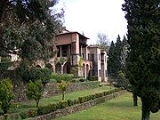
Yuste
Encyclopedia

Yuste Monastery is in the small village now called Cuacos de Yuste
Cuacos de Yuste
Cuacos de Yuste is a village in the province of Cáceres and autonomous community of Extremadura, Spain. It is best known for the Monastery of Yuste, Where Charles V retired and died....
(in older works St. Yuste or St. Just) in the province of Cáceres in the autonomous community of Extremadura
Extremadura
Extremadura is an autonomous community of western Spain whose capital city is Mérida. Its component provinces are Cáceres and Badajoz. It is bordered by Portugal to the west...
, Spain
Spain
Spain , officially the Kingdom of Spain languages]] under the European Charter for Regional or Minority Languages. In each of these, Spain's official name is as follows:;;;;;;), is a country and member state of the European Union located in southwestern Europe on the Iberian Peninsula...
. The monastery was founded by the strict Hieronymite
Hieronymites
Hieronymites, or the Order of St. Jerome , is a common name for several congregations of hermits living according to the Rule of St. Augustine, with supplementary regulations taken from the writings of the 5th-century monk and scholar, St Jerome. The principal group with this name was founded in...
order of monks in 1402.
In 1556 Charles V, Holy Roman Emperor
Charles V, Holy Roman Emperor
Charles V was ruler of the Holy Roman Empire from 1519 and, as Charles I, of the Spanish Empire from 1516 until his voluntary retirement and abdication in favor of his younger brother Ferdinand I and his son Philip II in 1556.As...
retired to the Monastery of Yuste, near Cuacos de Yuste, after having abdicated the Spanish crown in favour of his son Philip II of Spain
Philip II of Spain
Philip II was King of Spain, Portugal, Naples, Sicily, and, while married to Mary I, King of England and Ireland. He was lord of the Seventeen Provinces from 1556 until 1581, holding various titles for the individual territories such as duke or count....
and the crown of the Holy Roman Empire
Holy Roman Empire
The Holy Roman Empire was a realm that existed from 962 to 1806 in Central Europe.It was ruled by the Holy Roman Emperor. Its character changed during the Middle Ages and the Early Modern period, when the power of the emperor gradually weakened in favour of the princes...
in favour of his brother Ferdinand I
Ferdinand I, Holy Roman Emperor
Ferdinand I was Holy Roman Emperor from 1558 and king of Bohemia and Hungary from 1526 until his death. Before his accession, he ruled the Austrian hereditary lands of the Habsburgs in the name of his elder brother, Charles V, Holy Roman Emperor.The key events during his reign were the contest...
. He intended to devote the rest of his life to prayer in this rather out of the way and obscure monastery. Nonetheless, the monastery had to be expanded that year to make room for the emperor and the 50 or 60 members of his entourage.
From time to time, well-known people, including his illegitimate son Don Juan de Austria, as well as his heir Philip II of Spain
Philip II of Spain
Philip II was King of Spain, Portugal, Naples, Sicily, and, while married to Mary I, King of England and Ireland. He was lord of the Seventeen Provinces from 1556 until 1581, holding various titles for the individual territories such as duke or count....
, came to visit the retired emperor. A fictitious visit by Carlos, Prince of Asturias and other characters provides the moonlit setting for the last act of Giuseppe Verdi
Giuseppe Verdi
Giuseppe Fortunino Francesco Verdi was an Italian Romantic composer, mainly of opera. He was one of the most influential composers of the 19th century...
's opera Don Carlos
Don Carlos
Don Carlos is a five-act grand opera composed by Giuseppe Verdi to a French language libretto by Camille du Locle and Joseph Méry, based on the dramatic play Don Carlos, Infant von Spanien by Friedrich Schiller...
. Charles died there on September 21, 1558. He was buried in the monastery church, though his remains were later transferred to San Lorenzo del Escorial.
During the Peninsular War
Peninsular War
The Peninsular War was a war between France and the allied powers of Spain, the United Kingdom, and Portugal for control of the Iberian Peninsula during the Napoleonic Wars. The war began when French and Spanish armies crossed Spain and invaded Portugal in 1807. Then, in 1808, France turned on its...
, the monastery was burnt to the ground. It was left in ruins until 1949, when the Spanish government restored it at the behest of Francisco Franco
Francisco Franco
Francisco Franco y Bahamonde was a Spanish general, dictator and head of state of Spain from October 1936 , and de facto regent of the nominally restored Kingdom of Spain from 1947 until his death in November, 1975...
.
The area around Yuste, the Valle del Jerte, is now an eco-tourist destination. Tourists can visit the monastery, including the emperor's apartments. The valley is also known for its cherry trees and the beauty of the surrounding landscape.

